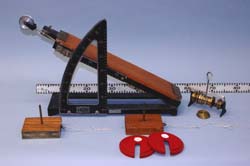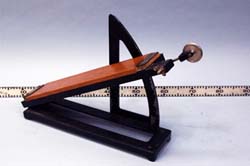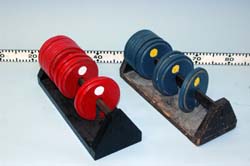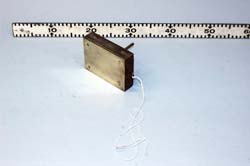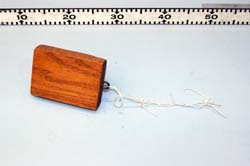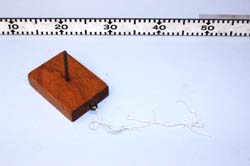|
Size: 1563
Comment:
|
← Revision 12 as of 2013-07-12 18:18:14 ⇥
Size: 5282
Comment: converted to 1.6 markup
|
| Deletions are marked like this. | Additions are marked like this. |
| Line 2: | Line 2: |
| ||<:30%>[:PiraScheme#Mechanics: Table of Mechanics Demonstration]||<:30%>[:MEEquipmentList: List of Mechanics Equipment & Supplies]||<:30%>[:Demonstrations:Lecture Demonstrations]|| | ||<:30%>[[PiraScheme#Mechanics| Table of Mechanics Demonstration]]||<:30%>[[MEEquipmentList| List of Mechanics Equipment & Supplies]]||<:30%>[[Demonstrations|Lecture Demonstrations]]|| |
| Line 7: | Line 7: |
| Applications of Newton's Laws, [:AppNewtonsLaws#Friction: 1K20. Friction] | Applications of Newton's Laws, [[AppNewtonsLaws#Friction| 1K20. Friction]] |
| Line 10: | Line 10: |
| * '''Cabinet:''' [:MechanicsCabinet:Mechanic (ME)] * '''Bay:''' [:MechanicsCabinetBayB5:(B5)] |
* '''Cabinet:''' [[MechanicsCabinet|Mechanic (ME)]] * '''Bay:''' [[MechanicsCabinetBayB5|(B5)]] |
| Line 14: | Line 14: |
| attachment:mainPhoto | {{attachment:mainPhoto.jpg}} |
| Line 18: | Line 18: |
| Insert succinct description of demonstration. | A weighted wood block is placed on an inclined plane with upward tension provided by a counterweight attached by a string running over a pulley. The tension is just enough to balance the weight so that the force due to static friction is just enough to prevent slipping. A nudge then triggers the block to slide. |
| Line 28: | Line 28: |
| * ''''' ''''' | * N/A |
| Line 33: | Line 33: |
| 1. List steps for setup then procedure. 1. ... |
1. Place the inclined plane on table near a corner closest to the audience so the they can see the protractor. 1. Choose an appropriate angle setting, and lock the plane into place with the set screw. 1. Choose one of the two wood blocks (brass bottom or wood bottom) to use and add weight if desired. 1. Choose the appropriate amount of counter weight to use and attach it to the block via the string. The amount of weight should barely balance the weight of the block so that the static frictional force is about to break. 1. Place the block on the inclined plane and run the string over the pulley with the weight hook hanging freely. 1. Help the system to stabilize if needed. If the weights were chosen correctly, the block should remain at rest. 1. Give the block a very small nudge. The block should begin to move down the plane. 1. To demonstrate how changing the coefficients of friction affects the system, the same procedure can be applied to the opposite block. To take away the difference in weights between the two blocks, a different, appropriately chosen weight combination and angle must be used. |
| Line 37: | Line 44: |
| * | * This demonstration may require practice and some minor calculations beforehand. |
| Line 42: | Line 49: |
| Discuss the physics behind the demonstration, explaining some of the various steps of the demonstration when appropriate. | Friction arises from topological imperfections of the two surfaces in contact; the rougher the surface, the harder it is to slide it across another surface. Fundamentally, it is thought to arise from Coulomb forces between the atoms in the material and their relative positions. It acts to oppose motion. The magnitude of static friction is F_fr ≤ μ*F_n = μ * m * g * cosθ where μ is the coefficient of static friction, m is the mass of the block, g is the acceleration due to gravity, and θ is the angle between the inclined plane and the table top. The net force along the inclined plane is the sum of the tension (equal to the counterweight treating the pulley as frictionless and massless) and the parallel component of the block's weight: F_net = T - W_||. If |F_net| > F_fr, the block will move. The direction of motion on the inclined plane will be in the direction of the bigger force (excluding friction). |
| Line 44: | Line 51: |
| ||attachment: photo||attachment: photo||attachment: photo||attachment: photo|| | {{attachment:IncPlaneDiagram.jpg}} The coefficient of static friction of polyurethane (which coats the wood) on polyurethane is known to be significantly greater than that of brass on polyurethane (source). The wood block has a mass of 238 grams while the brass-bottomed block has a mass of 451 grams. I.e. the brass-bottomed block will slip easier than will the wood block. There are many possible arrangements for this demonstration using various angles and combinations of weight. At small angles, a counterweight might not be necessary. At larger angles, a heavier counterweight may be used or more weight can be added to the block, putting more friction on it. If desired, this demonstration can be done using both blocks in two stages. It's a good idea to start with a lower angle using the regular wood block since it is less heavy and has a higher coefficient of friction. To take the weight dependance away, more weight can be added to the wood block to make it equal to that of the brass-bottomed block. Alternatively, more counterweight can be used for the brass-bottomed block while using a larger angle. A few rough calculations beforehand will provide a good starting point at each stage. ||{{attachment:IncPlaneWeights02-250.jpg}}||{{attachment:IncPlane01-250.jpg}}||{{attachment:Weights01-250.jpg}}||{{attachment:Weights02-250.jpg}}|| ||{{attachment:WoodBlock03-250.jpg}}||{{attachment:WoodBlock05-250.jpg}}||{{attachment:WoodBlock06-250.jpg}}||{{attachment:WoodBlock07-250.jpg}}|| |
| Line 47: | Line 63: |
| * [https://www.youtube.com/user/LectureDemostrations/videos?view=1 Lecture Demonstration's Youtube Channel] | * [[https://www.youtube.com/user/LectureDemostrations/videos?view=1|Lecture Demonstration's Youtube Channel]] |
| Line 51: | Line 67: |
| * List any references | * [[http://en.wikipedia.org/wiki/Friction|Friction - Wikipedia]] |
| Line 53: | Line 69: |
[:Instructional:Home] |
[[Instructional|Home]] |
Friction on an Adjustable Inclined Plane, 1K20.36
Topic and Concept:
Applications of Newton's Laws, 1K20. Friction
Location:
Cabinet: Mechanic (ME)
Bay: (B5)
Shelf: #1
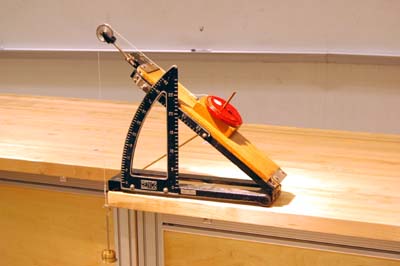
Abstract:
A weighted wood block is placed on an inclined plane with upward tension provided by a counterweight attached by a string running over a pulley. The tension is just enough to balance the weight so that the force due to static friction is just enough to prevent slipping. A nudge then triggers the block to slide.
Equipment |
Location |
ID Number |
|
|
|
Adjustable Inclined Plane |
ME, Bay B5, Shelf #1 |
|
Wood Blocks with Attached String |
ME, Bay B5, Shelf #1 |
|
Weights with Weight Hanger |
ME, Bay A1, Shelf #4 |
|
Important Setup Notes:
- N/A
Setup and Procedure:
- Place the inclined plane on table near a corner closest to the audience so the they can see the protractor.
- Choose an appropriate angle setting, and lock the plane into place with the set screw.
- Choose one of the two wood blocks (brass bottom or wood bottom) to use and add weight if desired.
- Choose the appropriate amount of counter weight to use and attach it to the block via the string. The amount of weight should barely balance the weight of the block so that the static frictional force is about to break.
- Place the block on the inclined plane and run the string over the pulley with the weight hook hanging freely.
- Help the system to stabilize if needed. If the weights were chosen correctly, the block should remain at rest.
- Give the block a very small nudge. The block should begin to move down the plane.
- To demonstrate how changing the coefficients of friction affects the system, the same procedure can be applied to the opposite block. To take away the difference in weights between the two blocks, a different, appropriately chosen weight combination and angle must be used.
Cautions, Warnings, or Safety Concerns:
- This demonstration may require practice and some minor calculations beforehand.
Discussion:
Friction arises from topological imperfections of the two surfaces in contact; the rougher the surface, the harder it is to slide it across another surface. Fundamentally, it is thought to arise from Coulomb forces between the atoms in the material and their relative positions. It acts to oppose motion. The magnitude of static friction is F_fr ≤ μ*F_n = μ * m * g * cosθ where μ is the coefficient of static friction, m is the mass of the block, g is the acceleration due to gravity, and θ is the angle between the inclined plane and the table top. The net force along the inclined plane is the sum of the tension (equal to the counterweight treating the pulley as frictionless and massless) and the parallel component of the block's weight: F_net = T - W_||. If |F_net| > F_fr, the block will move. The direction of motion on the inclined plane will be in the direction of the bigger force (excluding friction).
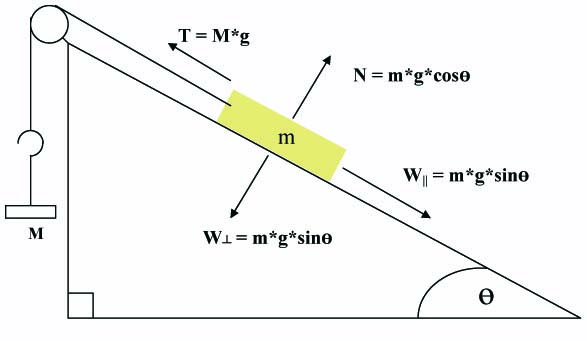
- The coefficient of static friction of polyurethane (which coats the wood) on polyurethane is known to be significantly greater than that of brass on polyurethane (source). The wood block has a mass of 238 grams while the brass-bottomed block has a mass of 451 grams. I.e. the brass-bottomed block will slip easier than will the wood block. There are many possible arrangements for this demonstration using various angles and combinations of weight. At small angles, a counterweight might not be necessary. At larger angles, a heavier counterweight may be used or more weight can be added to the block, putting more friction on it. If desired, this demonstration can be done using both blocks in two stages. It's a good idea to start with a lower angle using the regular wood block since it is less heavy and has a higher coefficient of friction. To take the weight dependance away, more weight can be added to the wood block to make it equal to that of the brass-bottomed block. Alternatively, more counterweight can be used for the brass-bottomed block while using a larger angle. A few rough calculations beforehand will provide a good starting point at each stage.
|
|
|
|
|
|
|
|
Videos:
References:
